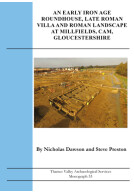Google Books previews are unavailable because you have chosen to turn off third party cookies for enhanced content. Visit our cookies page to review your cookie settings.
A Middle Bronze Age Ring Ditch and Roman Settlement Enclosures at Netherhouse Copse, Hitches Lane, Fleet, Hampshire (Paperback)
Imprint: Thames Valley Archaeological Services
Series: TVAS Occasional Paper Series
Pages: 63
ISBN: 9781911228509
Published: 28th January 2021
Script Academic & Professional
Series: TVAS Occasional Paper Series
Pages: 63
ISBN: 9781911228509
Published: 28th January 2021
Script Academic & Professional
Usually available in 6-8 weeks.
You'll be £13.00 closer to your next £10.00 credit when you purchase A Middle Bronze Age Ring Ditch and Roman Settlement Enclosures at Netherhouse Copse, Hitches Lane, Fleet, Hampshire. What's this?
+£4.99 UK Delivery or free UK delivery if order is over £40
(click here for international delivery rates)
Need a currency converter? Check XE.com for live rates
(click here for international delivery rates)
Need a currency converter? Check XE.com for live rates
This volume presents results of archaeological investigations on one large and several smaller areas within a site in an area close to the north-eastern border of Hampshire, which until recently had received relatively little archaeological investigation. Use of the site began in the Middle Bronze Age with the digging of ditches and a ring ditch. The ring ditch (barrow) was only 4m across and was associated with an urned cremation burial which returned a Middle Bronze Age radiocarbon date of 1214-1012 cal BC. No dated artefacts were recovered from the ring ditch. Area F revealed a pair of linear features aligned at right angles to each other, of Middle to Late Bronze Age date, containing pottery and returning two radiocarbon dates of 1256-1156 cal BC and 1111-970 cal BC. They are considered to be elements of a Bronze Age field system, but the location of any contemporary settlement remains unknown. There was then a lengthy gap until Roman use of the site which formed an agricultural settlement, as an initial enclosure which developed in at least five phases, three early Roman and two late, apparently with a break in between. The settlement is considered to have been of modest status in all phases, with no conspicuous examples of material wealth, and certainly no elaborate architecture, but the occupants were not necessarily impoverished and certainly disposed of a substantial pottery assemblage. On the basis of admittedly tentative evidence, the economy of the site is considered to have been predominantly pastoral. The results are related to recent excavations on a nearby site to the north.
Other titles in the series...
Other titles in Thames Valley Archaeological Services...










